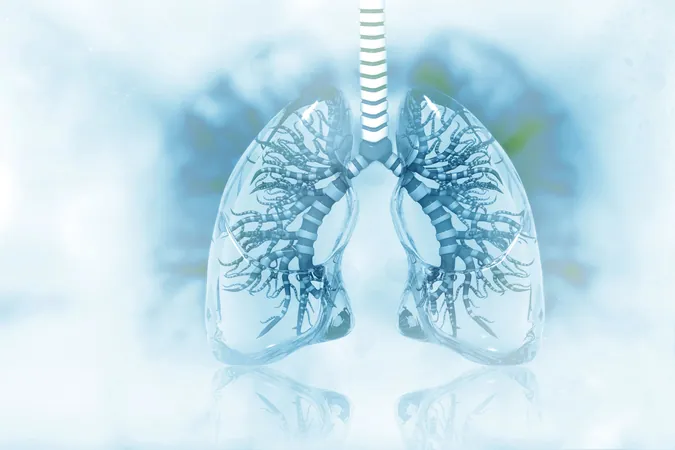
Asthma Rates Surge Amidst COVID-19: What You Need to Know!
2025-04-08
Author: Wei Ling
Introduction
The global landscape of asthma incidence and prevalence has undergone a significant transformation during the COVID-19 pandemic, with particularly alarming increases noted among children under five and in regions with high sociodemographic indices. A recent study published in Public Health highlights these trends, indicating a pressing need for further investigation into the intertwining of asthma and COVID-19.
Insights from Experts
Dennis Williams, PharmD, BCPS, AE-C, an associate professor at the Eshelman School of Pharmacy at the University of North Carolina at Chapel Hill, expressed caution regarding the implications of these findings, stating, "This is a complicated issue… We need to see what happens over the next 3 to 5 years." He posited three critical observations: firstly, COVID-19 may indeed impact asthma prevalence; secondly, the SARS-CoV-2 virus significantly affects the immune system, particularly within the lungs; and lastly, individuals predisposed to bronchial hyperreactivity—an asthma characteristic—are likely more susceptible to the virus.
Symptoms and Risks
The Asthma and Allergy Foundation of America draws attention to the overlapping symptoms of asthma and COVID-19, which include dry cough, shortness of breath, and difficulty breathing. While studies indicate that asthma does not inherently increase the risk of severe COVID-19 illness, researchers have found that COVID-19 can trigger asthma episodes, akin to the effects of influenza or respiratory syncytial virus (RSV).
Global Asthma Statistics
Utilizing data from the Global Burden of Disease Study 2021, researchers calculated age-standardized incidence, prevalence, and death rates for asthma. The findings revealed alarming rates: the global asthma incidence rate was around 516.70 per 100,000 individuals, with the prevalence soaring to approximately 3,340.12 per 100,000 in 2021. Particularly concerning, regions with high sociodemographic indices reported the highest incidence (879.28 per 100,000) and prevalence rates (6,755.31 per 100,000), while low-middle and low sociodemographic regions recorded significant death rates.
Trends During the Pandemic
From the onset of the pandemic, asthma incidence and prevalence have surged by 5.26 and 23.10 per 100,000, respectively, despite a slight decrease in mortality rates. In the United States, the incidence rate rose to 17.63 per 100,000 during this critical period.
Research Findings on New-Onset Asthma
Moreover, new research published in the Journal of Allergy and Clinical Immunology: In Practice identified potential links between COVID-19 infections and new-onset asthma cases, particularly related to eosinophilic inflammation. In a study involving 394 recovered COVID-19 patients, researchers found that 17 individuals received a potential new asthma diagnosis—though only 6 were confirmed cases.
A Decrease in Exacerbations?
Williams noted an intriguing trend during the pandemic, wherein some publications reported decreased asthma exacerbations. This decrease may correlate with decreased exposure to other viral infections due to mask-wearing and social distancing measures.
The Path Forward
As the healthcare community braces for the return of circulating viruses and the potential rise in respiratory illness cases, Williams emphasizes the importance of vaccinations. The emergence of the H5N1 bird flu virus heightens concerns for asthma patients, underscoring the necessity for ongoing education about respiratory protective measures, timely vaccinations, and adherence to asthma treatment plans.
Conclusion
With a landscape changing rapidly, those afflicted with asthma should stay informed and vigilant. As health professionals continue to untangle the links between respiratory illnesses and viral infections, the importance of proactive healthcare cannot be overstated. Stay tuned, as future studies may shift our understanding of asthma management in the post-pandemic world!


 Brasil (PT)
Brasil (PT)
 Canada (EN)
Canada (EN)
 Chile (ES)
Chile (ES)
 Česko (CS)
Česko (CS)
 대한민국 (KO)
대한민국 (KO)
 España (ES)
España (ES)
 France (FR)
France (FR)
 Hong Kong (EN)
Hong Kong (EN)
 Italia (IT)
Italia (IT)
 日本 (JA)
日本 (JA)
 Magyarország (HU)
Magyarország (HU)
 Norge (NO)
Norge (NO)
 Polska (PL)
Polska (PL)
 Schweiz (DE)
Schweiz (DE)
 Singapore (EN)
Singapore (EN)
 Sverige (SV)
Sverige (SV)
 Suomi (FI)
Suomi (FI)
 Türkiye (TR)
Türkiye (TR)
 الإمارات العربية المتحدة (AR)
الإمارات العربية المتحدة (AR)